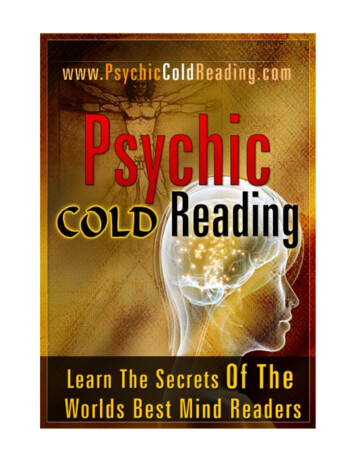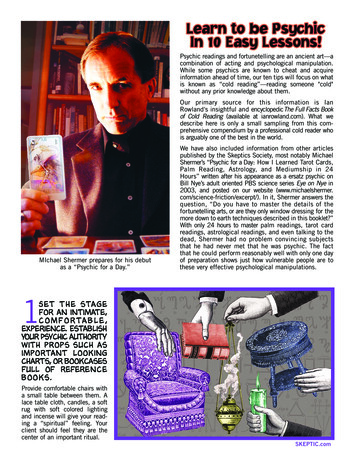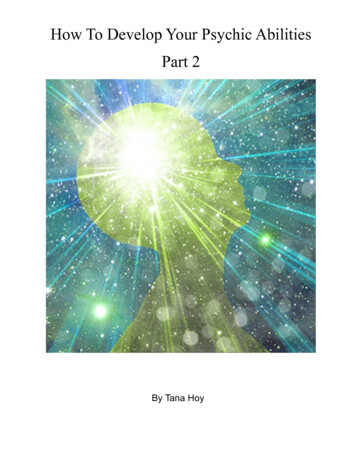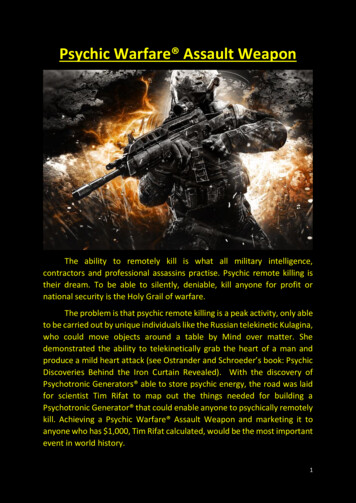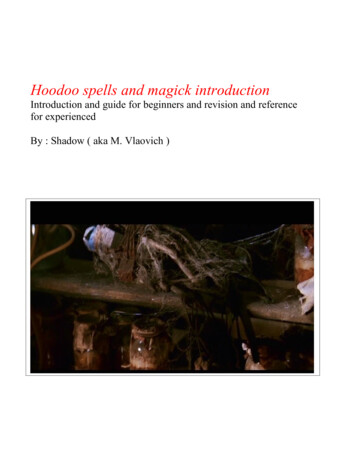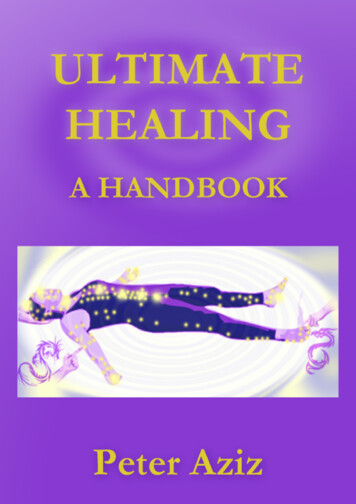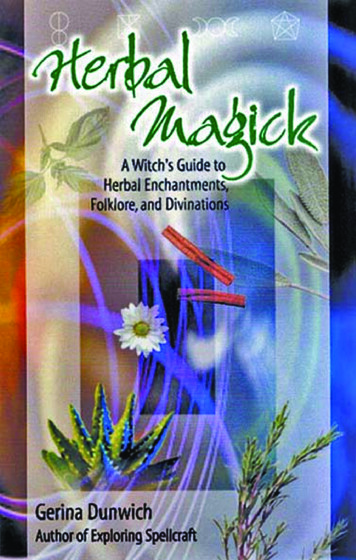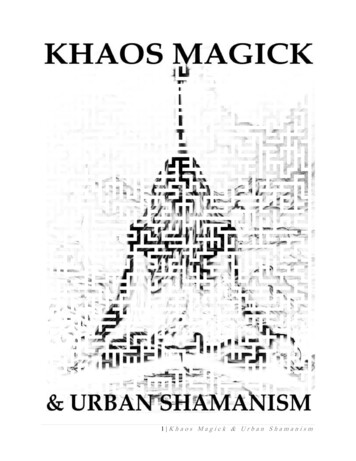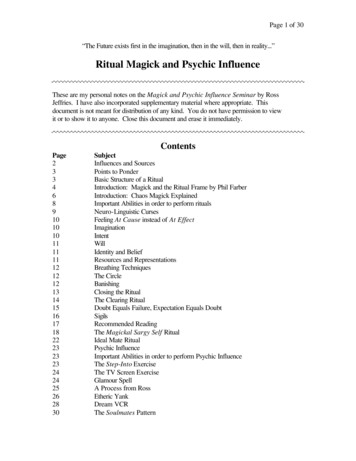
Transcription
Page 1 of 30“The Future exists first in the imagination, then in the will, then in reality.”Ritual Magick and Psychic InfluenceThese are my personal notes on the Magick and Psychic Influence Seminar by RossJeffries. I have also incorporated supplementary material where appropriate. Thisdocument is not meant for distribution of any kind. You do not have permission to viewit or to show it to anyone. Close this document and erase it 3141516171822232323242425262830SubjectInfluences and SourcesPoints to PonderBasic Structure of a RitualIntroduction: Magick and the Ritual Frame by Phil FarberIntroduction: Chaos Magick ExplainedImportant Abilities in order to perform ritualsNeuro-Linguistic CursesFeeling At Cause instead of At EffectImaginationIntentWillIdentity and BeliefResources and RepresentationsBreathing TechniquesThe CircleBanishingClosing the RitualThe Clearing RitualDoubt Equals Failure, Expectation Equals DoubtSigilsRecommended ReadingThe Magickal Sargy Self RitualIdeal Mate RitualPsychic InfluenceImportant Abilities in order to perform Psychic InfluenceThe Step-Into ExerciseThe TV Screen ExerciseGlamour SpellA Process from RossEtheric YankDream VCRThe Soulmates Pattern
Page 2 of 30Influences and Sources Neuro-Linguistic Programmingo A study of the structure of the internal human experience. Based on thehypnosis of Milton Erickson, the therapeutic work of Virginia Satir, andthe work of Fritz Perls, originator of Gestalt therapy. NLP was inventedby Richard Bandler and John Grinder.o Ross Jeffries laid further NLP groundwork with the invention of SpeedSeduction.o Some of the Psychic Influence material is derived from the NLP work ofTom Vizzini and Kim McFarland of Essential Skills. Silva Mind Controlo Hypnosis, meditation, alpha state, visualization, ESP. Huna Magic (A Polynesian system of magick)o Choose beliefs and identities based on effectiveness. create your ownpersonal reality.Energy flows where attention goes. Yogao An eastern discipline of breathing and meditation that incorporatesphysical movement and the physiology. Ritual Magick as described in FutureRitual by Phil Farbero Heavily influenced by NLP, Thelemic and Chaos magick, and the researchof Aleister Crowley. Chaos Magicko System of magick originated by Austin Osman Spare. Heavilyincorporates symbology. Primary assumption is that belief is a tool forachieving effects; it is not an end in itself. Jungian Psychologyo System of psychology focused on symbols, archetypes, andcommunication with the unconscious mind through dream interpretation.
Page 3 of 30Points to Ponder This document is structured such that you will have to read it more than oncein order to fully grasp all of the concepts involved. Let it sink in. Think of everything in this document from an NLP perspective. Magick,in this context, cannot change physical law. All you are doing isprogramming your own brain and harnessing the resources available in yourown unconscious mind. The point of magick, in the context of this document, is to accomplishyour will by focusing and controlling your energy, imagination, state, andintent. Therefore, in order to be effective, it is of the utmost importance tolearn how to focus your intent, use your imagination, change your state, anddirect your energy. Here is Ross’s definition: “Magick is change inaccordance with one's will and imagination, utilizing the energy ofbody, breath and mind.” Obtain and use a Magick Journal. Keep notes. Always spend some time studying / designing any ritual before performing it. The Clearing Ritual is a small, basic, 3-step ritual that is effective and usesone breathing technique. You can perform it for a few days to get started,while you are studying to perform the bigger ritual. When you feel prepared to perform the “Magickal Sargy Self” ritual, startdoing it 3 times per week. Note all your thoughts / states / experiences in yourMagick Journal.Basic structure of a ritualForm a specific statement of intent.Energize with BreathingBanish, to clear a ritual space.Perform the ritual itself.Close the ritual.
Page 4 of 30Magick and the Ritual FrameBy Philip H. FarberWhat do you think of when you read the term "magick"? Witches performingspells? Medieval ceremonialists in hooded robes? Stage illusionists pullingbunnies out of hats? Special effects from fantasy films? Some force that youbelieve or don't believe in? Allow me to ask you to set those mythic ideas aside fornow. While this discussion may eventually wind its way back to the realm of theremarkable, I'd like to start in a much more familiar place.The broadest definition of magick was offered in the early 20th Century by theoccultist Aleister Crowley who suggested that magick was "the art and science ofcausing change in conformity with will." (Crowley was also responsible forreturning the "K" to the spelling of "magick," to distinguish the mental andspiritual discipline from stage illusion.) For the purposes of our immediatediscussion, I'd like to narrow that down a little further and say that magick is theart and science of using ritual technology to cause change. In short, the work ofthe magician is to do whatever is necessary to create an altered state that results inchange and a desired outcome. Sound familiar? From this point of view, theboundary between hypnosis as we know it and magick as we might learn to acceptit is somewhat vague. The essential difference that I'll offer here is the concept of a"ritual frame."We encounter ritual frames every day. Ritualizing seems to be a fundamentalhuman behavior, something we use and experience in many aspects of our lives.For instance, if you choose to have a romantic dinner with someone special, there'sa particular ritual that you may use to enhance the situation, create an altered state,and achieve the desired outcome of romance. No "love spell" is necessary toperform this magick - the ritual is simply to ensure that every aspect of thesituation is aligned with the goal: the lights are dimmed, the candles lit, thechampagne chilled, the food perfect, the music soft and suggestive. If you get thatritual right, then an altered state is produced - a comfortable sharing, perhaps - andyour desired outcome - romance - is achieved. This ritual can be repeated withvariations to achieve a romantic effect time after time.Similarly, most of us have rituals that we use to prepare for a day of work.Personally, I shower, meditate for a short while, eat a light breakfast, put on somepresentable clothes, and make sure my office is clean and ready. I repeat that ritualeach time I want to enter the state of mind necessary to engage in my work as ahypnotherapist. And then there's yet another ritual frame that is created when myclient walks through the door - the way I greet him or her, the pre-session talk, anychanges in the lighting or music, the invitation to sit in the trance chair, and so on.Formal trance induction and NLP methods also often involve ritual frames that
Page 5 of 30provide a setting for the content of the session. We each develop the ritual framesthat work best for us.Just as the Ericksonian definition of hypnosis suggests, "Trance permits theoperator to evoke in a controlled manner the same mental mechanisms that areoperative spontaneously in everyday life," we may find that magick is subject to avery similar definition. The mental mechanisms, however, may have a slightlydifferent emphasis, with magick being more concerned with our ability to createritual frames "in a controlled manner."The examples I've just given - romance and preparation for work - are commonand naturally- occurring uses of ritual. A glance at a medieval grimoire (magicaltextbook or collection of rituals), however, will offer up rituals that are perhapsnot quite so easily understood. Ancient languages form chants and calls that areembellished with symbolic gestures, actions, sounds, and images. One of theexplanations for the arcane qualities of these rituals is simply that these ritualactions had more natural meaning in the context of the medieval world. Whilesome of the elements may seem bizarre to those of us living in the 21st Century,they may have been more familiar to the clerics and alchemists of the Dark Ages.There's more, however. Most of the rituals found in old texts like "The Keys ofSolomon" or "The Sacred Magick of Abramelin the Mage" had very specific andvery intense purposes. The idea was to create altered states of singular depth andutility.Here's another point of commonality with hypnosis. While some rituals definitelyhad consciously directed purposes (not unlike the "romance" example above), theforms that were described as "High Magick" were more interested in connectingthe conscious mind with that part of the unconscious variously referred to byritualists of yore as "the high self," "the perfected self," or "the Holy GuardianAngel." Like the "benevolent unconscious" found in some models of hypnosis, the"perfected self" was understood as an intelligence above and beyond the normalego-consciousness with a much greater understanding of the unique purpose anddirection of the individual. Outcomes of ritual work would ultimately be generatedfrom contact with that level of the unconscious. Just as some of the outcomes ofhypnotherapy may seem miraculous to the uninitiated, the results of thesepowerful rituals could definitely seem like. well, magick.Anyway, the point of all this just now is to introduce some concepts and terms thatwill come in handy as you further explore this site. In the meantime, think aboutthe use of ritual frames in your own life and work and perhaps you'll find aglimpse of -----------------------
Page 6 of 30Chaos Magick Explained(Author Unknown)[Note: I found this online, in a FAQ on Chaos Magick. It is provided here only to givesome context and history.]Chaos magick is the fruit of Austin Osman Spare and Peter Carroll's rebellionagainst the traditional magickal systems, which they deemed needlesslycomplicated, discriminatory and impotent.Influenced by both Spare and Carroll's scientific pursuits and interests, ChaosMagick is a 'non-system' focusing on the mechanism of 'belief' as a means toachieve a desired end. Belief in anything, -a force, a diety,- will be adopted for thepurpose of the magickal work at hand and then discarded after it has served itspurpose. To do this, magicians must become skilled in changing their beliefs at amoment's notice and 'believing' that "Nothing is True and Everything is Permitted"as Ray Sherwin wrote in 'The Theatre Of Magick' "The (Chaos) Magician believesnothing in the sense of having faith. He experiments practically to ascertain ifthere is any value in the postulates he has either originated or borrowed fromelsewhere. It is a fact that we all must hold certain organic beliefs for the sake ofconvenience. You all believe that the chairs you are sitting in are real -- most ofthe time. This is not however a mental process, but rather an instinctive or organicone without which life would be impossible."The path of Chaos is not one for the weak or fearful. You must realize that you areentirely on your own and free to do as you please, therefore you alone areresponsible for the outcome of your actions. You will not find 'Karma' or 'The Lawof Three' in Chaos Magick to comfortably set your limits for you. Chaos Magick isnot black, white or gray, it is simply neutral energy which you will shape into yourintention. Therefore, unless you have a solid code of ethics and know what you aredoing, Chaos Magick is not for you, indulge in foolishness and you will quickly beon the way to self-annihilation.In Chaos Magick it is up to you to use or create whatever methods of ritual ormagickal workings you desire, however there are three core practises that Chaotescommonly use and they are: gnosis, god-form/servitor work, and sigilization.Chaos magick relies on 'gnosis' an altered state of mind to achieve effects. It is astate of single-mindedness that can be achieved through yoga, drumming,chanting, dancing, sex and masturbation and through the use of certain drugs. Youwill know that you are in a state of gnosis once your mind stops rationalizingabout your experience.it is the gateway into your subconscious.
Page 7 of 30Chaotes generally don't worship a 'god', but as mentioned above they willtemporarily believe in any god-form required to make their magick work. Workingwith god-forms in Chaos Magick involves the same or similar invocation orevocation methods used in traditional systems. Unlike god-forms that alreadyexist, servitors are magickal beings, created by a magician to perform a certaintask. Servitors are created in a state of gnosis and stored in a material object suchas sigil, which then enables the magician to summon, communicate and affect it.There are mainly two types of Servitors; "Egregores" which are large servitorsusually created by a group of magicians and remain in existence indefinitely, and"Independent Thought-Forms" which are usually active for the duration of themagickal working and then destroyed by the magician.Sigil Magick was developed by Spare and involves the creation of an abstractimage of the magicians written will or intent and absorbing the sigil into thesubconscious in a state of gnosis. It then, should be forgotten and the material sigildestroyed, for it is believed that once the sigil is in the subconscious mind it willoperate unaided.Chaos magick is path of complete magickal freedom, make your choices carefullyand be responsible. Above all, if such freedom makes you uncomfortable and youfeel a compelling need to be governed by dogmas, then steer clear from the path ofChaos or your sanity just might get swept away.
Page 8 of 30Important abilities in order to perform rituals1) Ability to perform various breathing techniques. Ross: “Few people bre
Magick, in this context, cannot change physical law. All you are doing is programming your own brain and harnessing the resources available in your own unconscious mind. The point of magick, in the context of this document, is to accomplish your will by focusing and controlling your energy, imagination, state, and intent.File Size: 721KBPage Count: 30

